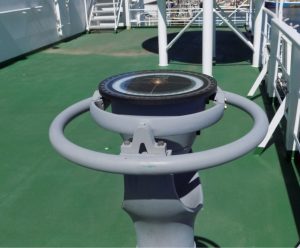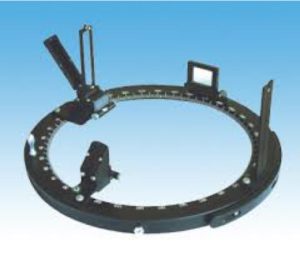The instrument which is used to measure and display bearings/courses is known as a compass. There are two basic types of compass used at sea:
- The Gyro compass.
- The Magnetic compass.
On large merchant ships it is not unusual for it to be equipped with two gyro compasses and one magnetic compass. The reason for this is to provide a back-up in the event of compass failure.
The gyro compass.
The gyro or gyroscope comprises basically a rapidly spinning wheel, the axis of which, according to the physical laws of nature, will always point in the direction it is set, provided that nothing is disturbed. The gyro compass is mounted in gimbals, the axis of which is made to point towards true north along the true meridian. All bearings taken with this compass will be true bearings. The outer edge of the compass and its repeaters are graduated clockwise from 000° to 360°. Although it is very steady when set, it may not always point exactly to true north for a variety of reasons. It may settle a degree or two either side of the meridian. This is referred to as gyro error and the compass is said to be reading either “high” or “low”. For example:
- The gyro bearing of an object is 065°, while the true bearing of the object is known to be 067°. The gyro compass is therefore reading 2° low. In order to obtain a true bearing when the gyro is low, the difference between the two must be added to the gyro bearing. If the gyro error is high, the difference must be subtracted from the gyro reading.
The gyro itself is usually mounted in a compartment on the bridge and the bearing of the ships head is fed via electric cable to repeaters placed in various positions on the bridge and bridge wings. The compass cards in the repeaters are synchronised with that of the gyro. The following are examples of typical repeaters:

Bearing repeater without azimuth ring.

Bearing repeater with azimuth ring.
The fixed line marked on the repeaters represents the ship’s head and is known as the “lubber’s line”. Bearings are taken via the azimuth ring which is placed on the repeaters. An example is shown below.

Azimuth ring.

Taking a bearing.
The magnetic compass.
The magnetic compass is basically a bar magnet attached to a compass card and suspended in a horizontal plane. Because it is unrestricted, it will always move in a horizontal plane and point to the approximate direction of north. Very seldom will it point to true north because the geographical or true poles do not coincide with the magnetic poles towards which the compass needle is attracted. When the magnetic needle is affected solely by the earth’s magnetic field, the direction of the needle is known as a “line of total force”. The vertical plane passing through the line of total force is known as the magnetic meridian . Since the earth’s magnetic field is not completely regular, the magnetic meridian will not necessarily pass through the magnetic poles.


